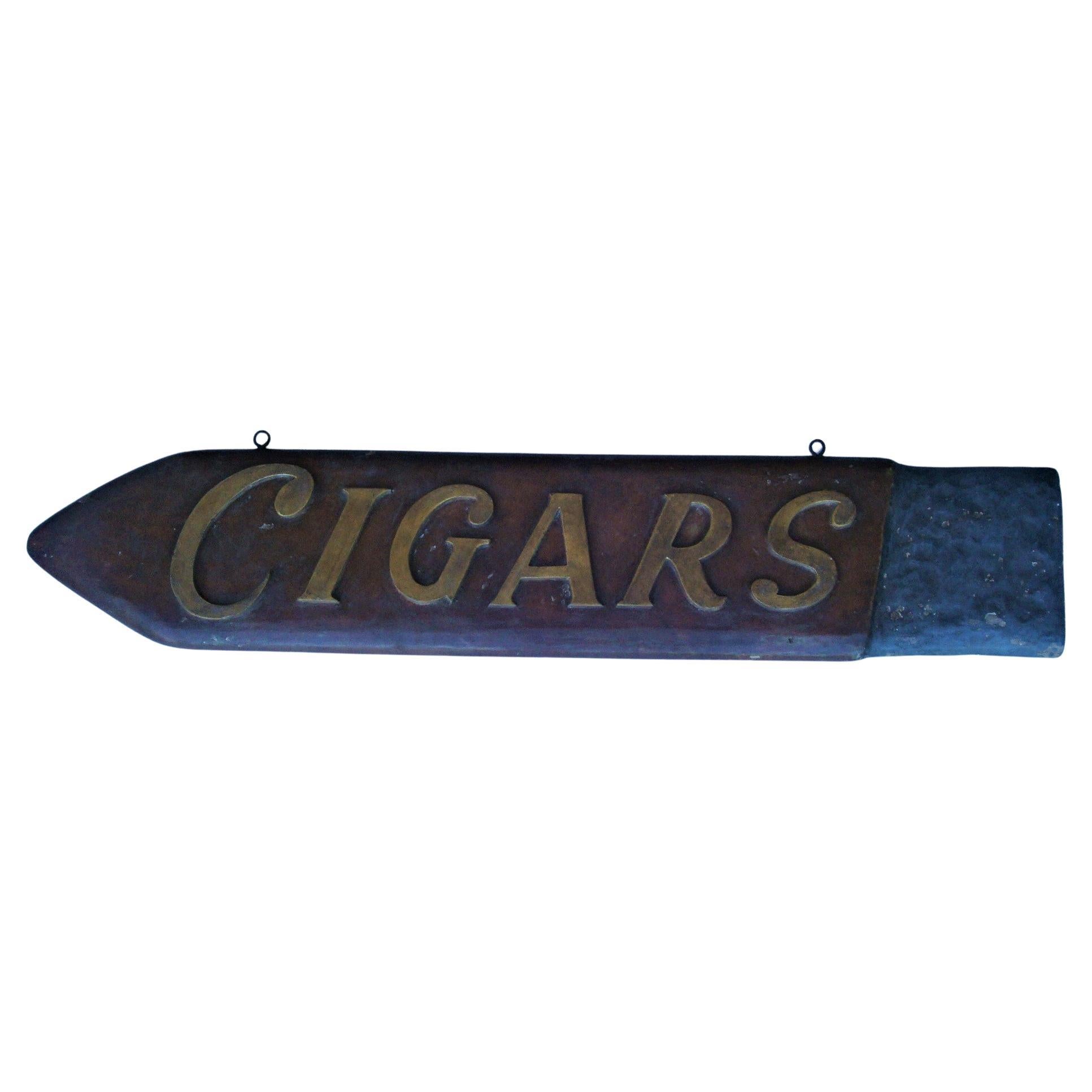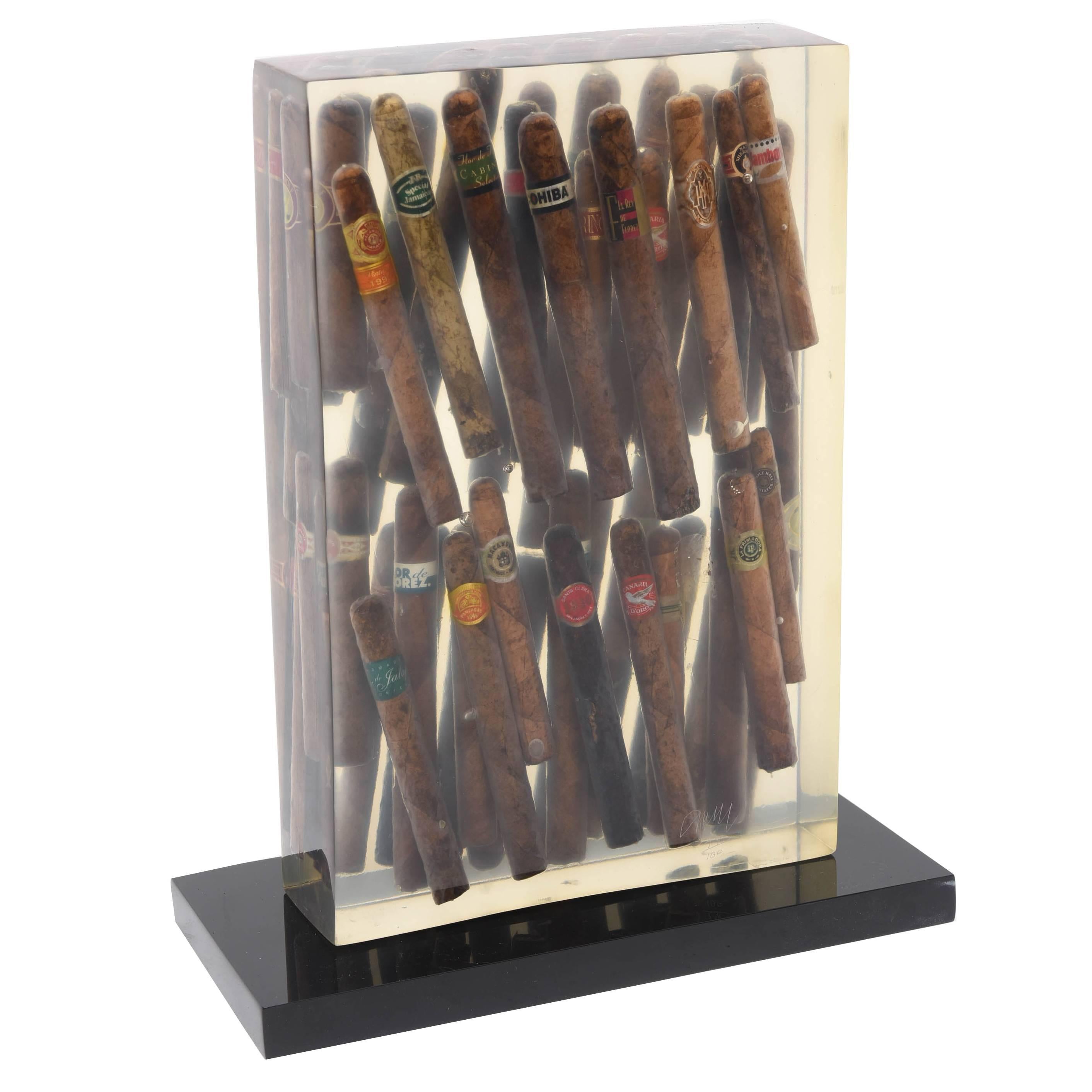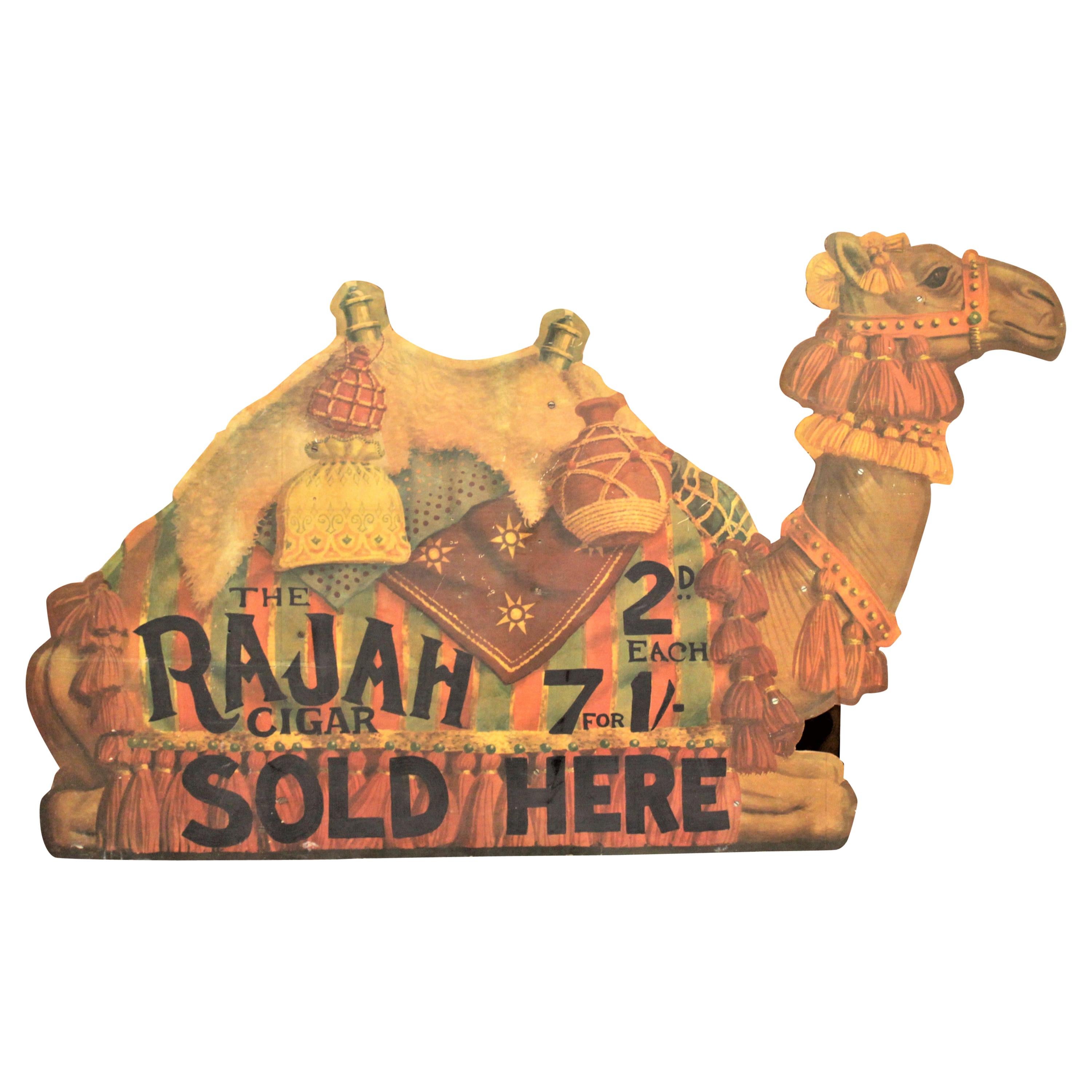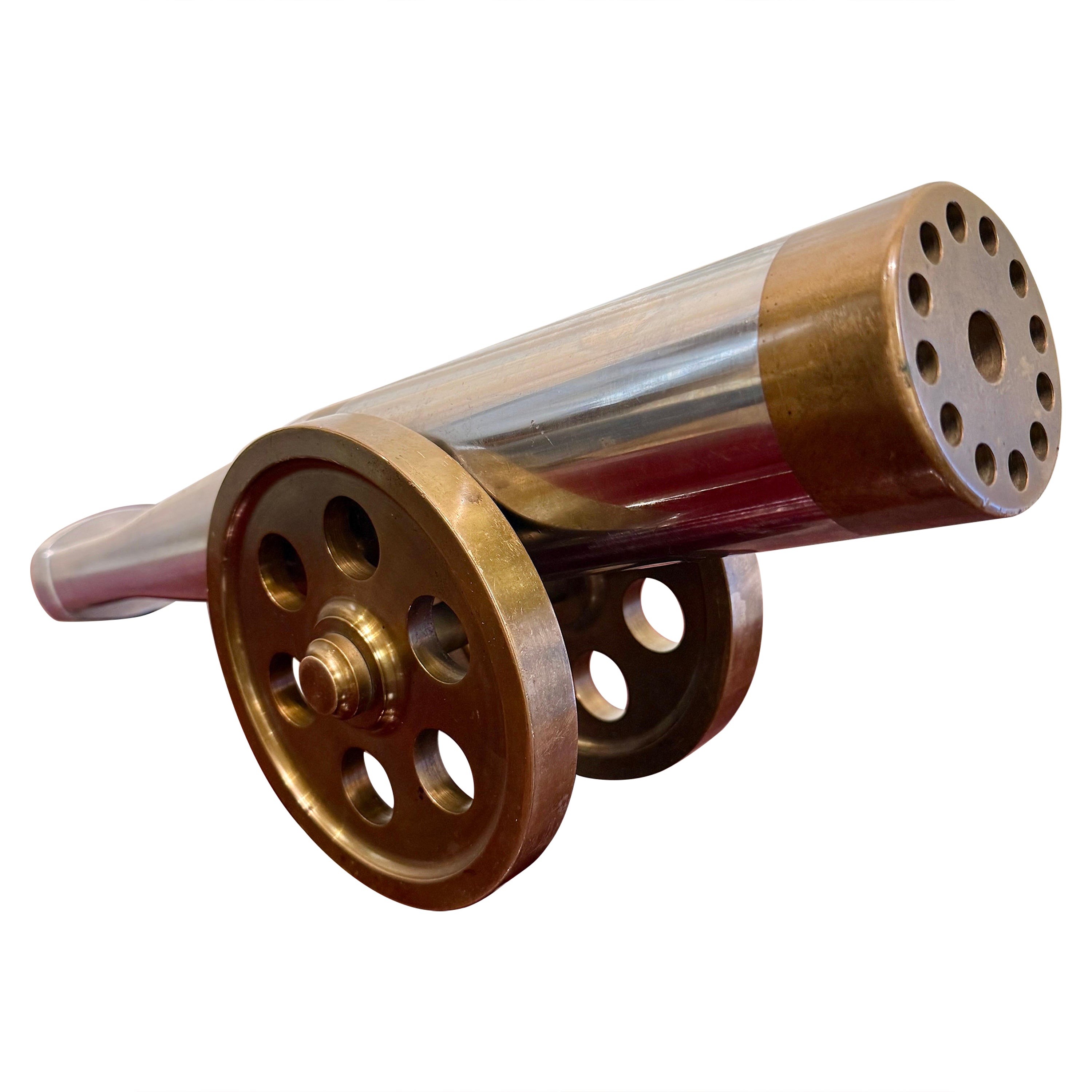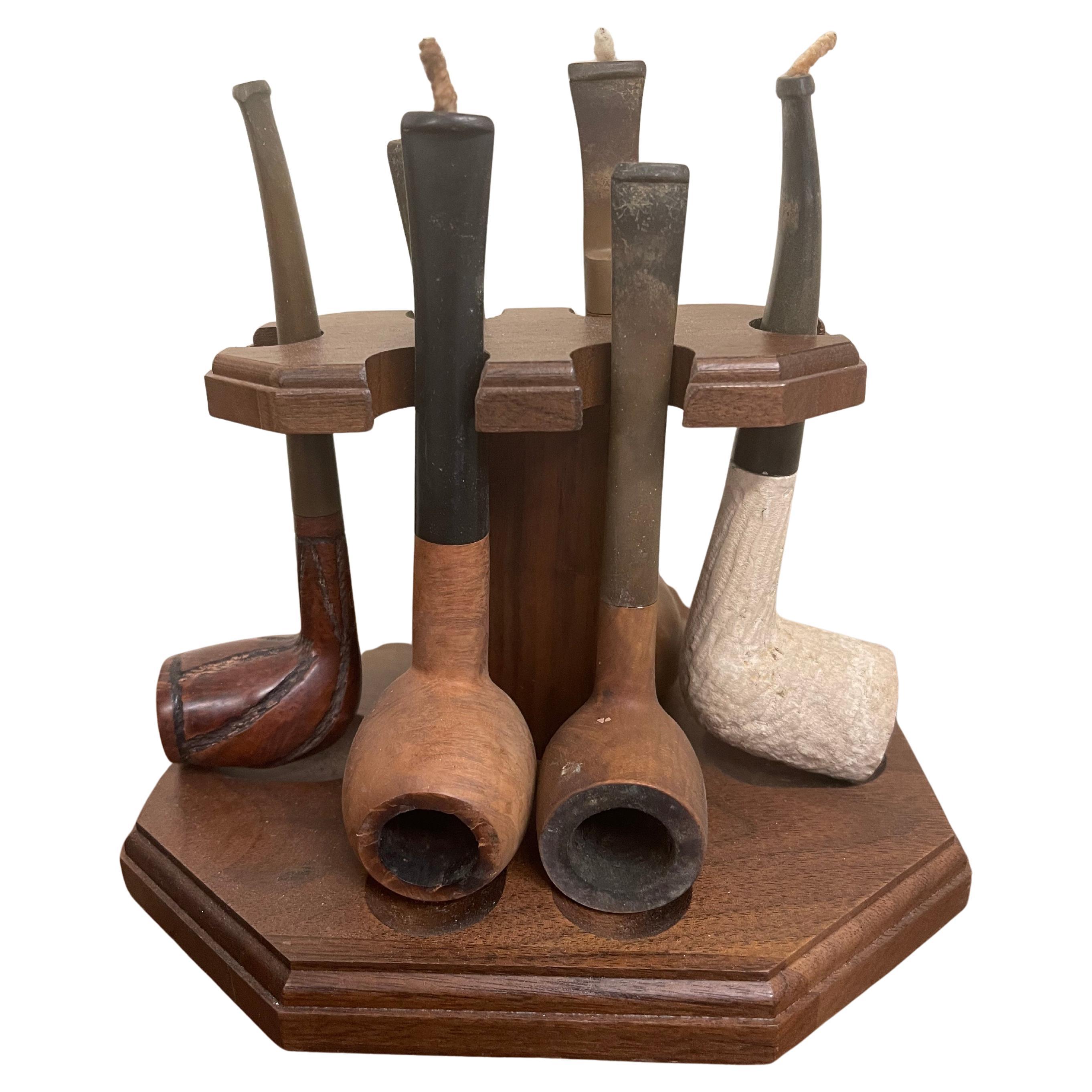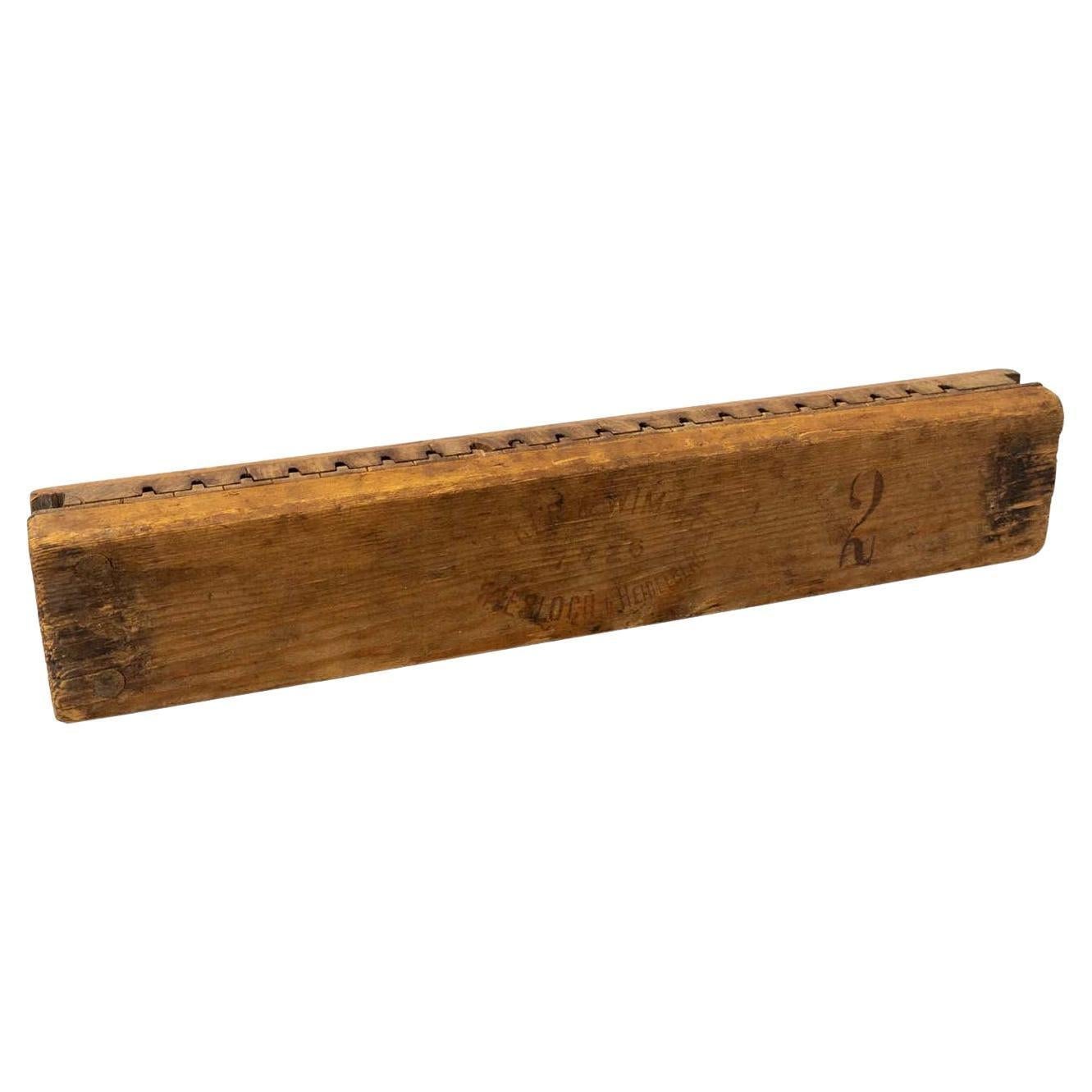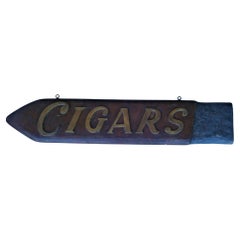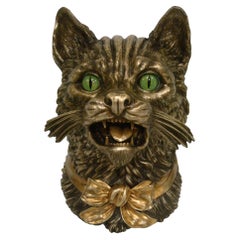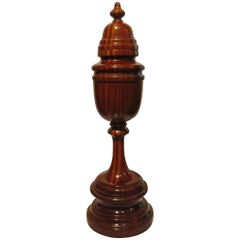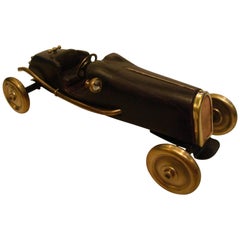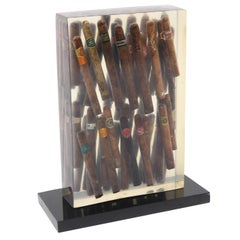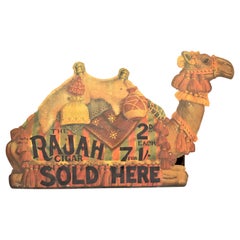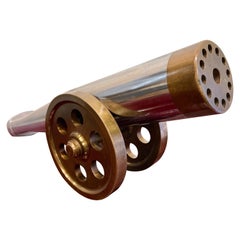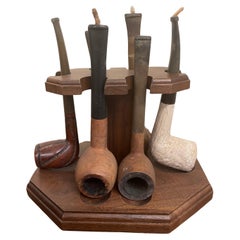Items Similar to Giant Advertising Cigar Statue / Bar Lounge / Cigars
Want more images or videos?
Request additional images or videos from the seller
1 of 20
Giant Advertising Cigar Statue / Bar Lounge / Cigars
$5,325
$7,10025% Off
£4,020.95
£5,361.2725% Off
€4,633.70
€6,178.2725% Off
CA$7,515.84
CA$10,021.1225% Off
A$8,286.04
A$11,048.0525% Off
CHF 4,334.99
CHF 5,779.9925% Off
MX$101,654.32
MX$135,539.1025% Off
NOK 54,568.92
NOK 72,758.5625% Off
SEK 51,030.57
SEK 68,040.7625% Off
DKK 34,604.63
DKK 46,139.5125% Off
About the Item
Giant Advertising Cigar Statue / Bar Lounge / Cigars.
Large Cigar Tobacco Trade Sign Cigars, made of wood with an iron and brass support. Fantastic Folk Art Sculpture.
This is a Giant / Big Cigar Advertising Sign Counters top sign.
This sign would date to late 30’s.
We have specialized in the sale of Art Deco and Art Nouveau and Vintage styles since 1995. If you have any questions we are at your disposal. Pushing the button that reads 'View All From Seller'. And you can see more objects to the style for sale. Why are there so many antiques in Argentina?
In the 1880 – 1940 there was a grate wave of immigration encouraged by the periods of war that were taking place. 1st World War took place between 1914 and 1918 2nd World War took place between 1939 and 1945 The immigrants options were New York or Buenos Aires. Tickets were cheap and in Buenos Aires they were welcomed with open arms, as it was a country where everything was still to be done. Argentina was the country of new opportunities, labour was needed and religious freedom was assured, in many cases the of the family travel first until they were settled and then the rest of the family members join them. In the immigrant museum “Ellis Island Immigrant Building” in New York you can se the promotional posters of the boats that would take them to a new life. Between the years 1895 and 1896, Argentina had the highest DGP (gross domestic product) per capita in the world according to the Maddison Historical Statistics index, this situation arose due to the large amount of food being exported to European countries, which were at war. The Argentinean ships left the port of Buenos Aires with food, but they returned with furniture, clothes and construction elements, (it´s common to see this the old buildings of the historic neighbourhood of San Telmo, the beams with the inscription “Made in England)”, as well as many markets that were built in Buenos Aires, such us the San Telmo Market, whose structure was brought by ship and afterwards assembled in 900 Defensa Street. With the great influence of European immigrants living in the country, the children of the upper classes travelled to study in France, resulting in the inauguration of “La Maison Argentinienne”, on 27th of June 1928, in the international city of Paris, which hosted many Argentinians that were studying in Frace. It´s the fourth house to be built after France, Canada and Belgium, being the first Spanish-speaking one. Still in place today (17 Bd Jourdan, 75014, Paris, France). Many of the children of these wealthy families who attended international art exhibitions, museums and art courses abroad, took a keen interest in the European style. This is why Buenos Aires was at the time referred as “The Paris of South America”. Between the years 1890 and 1920 more than a hundred Palaces were built on Alvear Avenue the most exclusive avenue in Buenos Aires. Today some of these palaces have been transformed into museums, hotels and embassies. In the year 1936, the Kavanagh building was inaugurated, it was the tallest reinforced concrete building in South America. During 1994 the American Society of Civil Engineers distinguished it as an “international engineering milestone”, and it´s now considered a World Heritage of Modern Architecture. At the time was common to hire foreign architects such as Le Corbusier, who visited Buenos Aires/Argentina in 1929 and in 1948 he drew up the blueprints for a house built in La Plata City (which was declared a World Heritage Site). In 1947, the Hungarian architect Marcelo Breuer designed “Parador Ariston” in the seaside city of Mar del Plata. After an Argentinean student at Harvard University convinced him to come to Argentina. He worked on an urban development project in the Casa Amarilla, area of La Boca. The Ukrainian architect, Vladimiro Acosta, arrives in Argentina in 1928 and worked as an architect until que moved to Brazil. Antonio Bonet, a Spanish architect who worked with Le Corbusier in Paris, arrives in Argentina in 1937, where he carried out several architectural works and in 1938 designs the well-known BFK chair. Andres Kálnay, of Hungarian origin, made around 120 architectural masterpieces, among which the former Munich brewery stands out, he even made the furniture’s design. The German architect, Walter Gropius, director of the Bauhaus, lived in Argentina, where he wrote articles for “Sur” magazine and founded in Buenos Aires, an architectural firm with Franz Möller, who was also an architect, where he built two houses. At the same time several famous designers decided to immigrate to Argentina, among them we can find the well-known French designer, Jean-Michel Frank, who arrived in the country in 1940 and also worked for the Rockefeller family. Special pieces were made, which were sold exclusively in the country, such as the well-known German company “WMF”, who sold their products by catalogue, which were chosen by the ladies of high society in the list of wedding gifts, as well as the pieces designed by Christofle. The Swiss sculptor Alberto Giacometti, made special pieces for Argentinean mansions. In 1904 the first Jansen branch outside Paris was established in Buenos Aires, as the Argentinean clientele demanded a large amount of furniture, from the end of the 19th century to the mid-20th century. In 1970, the brand Rigolleau Argentina made pieces authorised by Lalique. The brands Maple and Thompson also set up shop in the country. The French plastic artist, Marcel Duchamp moved to Argentina in 1918-1919. Glass signed Gallé, Charder, Leverre, Schneider, Muller and other French firms. They were bought in flower shops and were given to ladies with beautiful floral arrangements. Some furniture manufacturers travelled to international fairs and bough the patterns to produce the furniture in Argentina, such as the furniture firm Englander and Bonta, who bought the patterns in Italy. It is worth mentioning that in Argentina we have the largest community of Italians outside of Italy, as it is estimated that 70 percent of the inhabitants have at least one Italian descendant, followed by Spanish immigrants. The most Important furniture stores in Argentina: Comte is founded in 1934 (under the direct management of Jean Michel Frank in 1940). Nordiska (Swedish company established in 1934). Churba in 1960, a company that brought foreign designers to present their furniture in the country: Denmark: (Arne Jacobsen, Finn Juhl, Bender Madsen, Ejner Larsen, Poul Kjaerholm, Hans Wegner) Sweden: (Hans Agne Jakobsson, Gustavsberg) United States: (Herman Miller) Finland: (Lisa Johansson, Folke Arstrom, Tapio Wirkkala, Alvar Aalto, Timo Sarpaneva) Swedish Factory: (Orrefors) Italy: (Littala, Vico Magistretti, Emma Gismondi, Gae Aulenti, Angelo Mangiarotti, Elio Martinelli, Gianna Celada, Angelo Mangiarotti, Mario Bellini, Carlo Scarpa) Finland: (Olivia Toikka) Plata Lappas (Lappas Silver): a goldsmith shop founded in 1887 in Argentina by Alcibiades Lappas of Greek origin. In 2019, in Argentina took place “the Art Deco world congress” . Argentina currently has more than 100 Art Deco buildings and another 90 Art Nouveau buildings throughout the city of Buenos Aires. Argentina is a country that has not been involved in many wars, which is why it has been a refuge for works of art and antiques from different periods of time, unlike European countries. That is way many collectors, museums and antique dealers from all over the world visit it, you should not miss the opportunity to visit this great country.
- Dimensions:Height: 10.63 in (27 cm)Width: 27.56 in (70 cm)Depth: 6.3 in (16 cm)
- Style:Mid-Century Modern (Of the Period)
- Materials and Techniques:
- Place of Origin:
- Period:
- Date of Manufacture:1930´s
- Condition:Wear consistent with age and use.
- Seller Location:Buenos Aires, AR
- Reference Number:1stDibs: LU2027345313562
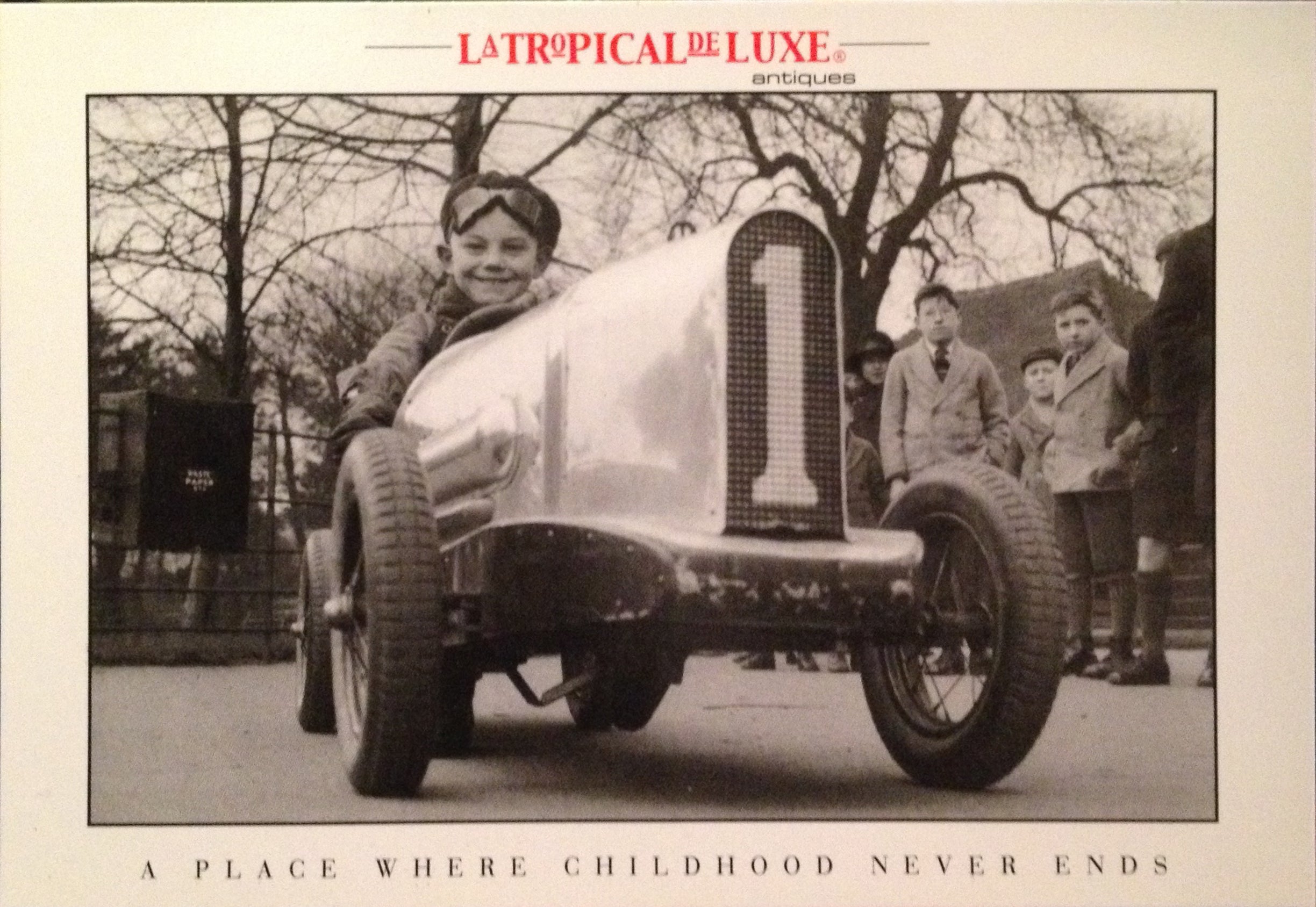
About the Seller
4.9
Vetted Professional Seller
Every seller passes strict standards for authenticity and reliability
Established in 2002
1stDibs seller since 2016
322 sales on 1stDibs
Typical response time: 1 hour
- ShippingRetrieving quote...Shipping from: Buenos Aires, Argentina
- Return Policy
Authenticity Guarantee
In the unlikely event there’s an issue with an item’s authenticity, contact us within 1 year for a full refund. DetailsMoney-Back Guarantee
If your item is not as described, is damaged in transit, or does not arrive, contact us within 7 days for a full refund. Details24-Hour Cancellation
You have a 24-hour grace period in which to reconsider your purchase, with no questions asked.Vetted Professional Sellers
Our world-class sellers must adhere to strict standards for service and quality, maintaining the integrity of our listings.Price-Match Guarantee
If you find that a seller listed the same item for a lower price elsewhere, we’ll match it.Trusted Global Delivery
Our best-in-class carrier network provides specialized shipping options worldwide, including custom delivery.More From This Seller
View AllCigars Store / Trade Folk Art Wooden Carved Sign. c 1900
Located in Buenos Aires, Olivos
American Folk art wooden "CIGARS" sign from the 1920's.
Great old Store Trade sign. Wood cut to cigar shape. Lettered in Gold Paint.
In good conditions, it was a in doors sign. Perfect for any cigar smoker.
Cigars History:
A cigar is basically dried tobacco leaves that are rolled and wrapped by other tobacco leaves in order to give you a full tobacco smoking experience.
Cigars are becoming more popular all around the world recently because they are exposed to a pop culture where a lot of famous people like Michael Jordan and Arnold Schwarzenegger smoke them.
In order to understand why cigars have become very well-known, we need to take a good look at their history and where they came from. That way, we can truly understand this pop phenomenon. Here is a brief history of cigars.
Origin of Cigars
The exact origin of cigars is not entirely known but historians believe that cigars were first invented by the ancient Mayans.
The ancient Mayans would collect tobacco leaves and wrap them up in a plantain leave in order to smoke it. An ancient Mayan pot...
Category
Early 20th Century American Folk Art Signs
Materials
Wood
Novelty Bronze Cigars / Cigarettes Humidor Formed as a Cat's Head Sculpture
Located in Buenos Aires, Olivos
For cat lovers, Silvered bronze humidor realistically shaped as a cat's head. Opens to reveal humidor space. Large container for cigards and smaller one for cigarettes or matches. La...
Category
Antique Mid-19th Century French Victorian Tobacco Accessories
Materials
Bronze
Giant Bishop Chess Piece Wooden Sculpture With Secret compartiment
Located in Buenos Aires, Olivos
Very nice giant Bishop chess piece. Made of several woods following a pattern. The top comes off, and it has something like an urn, maybe a secret hidden place.
Chess is a two-playe...
Category
Vintage 1910s Unknown American Classical Game Tables
Materials
Wood
Folk Art Early Racing Speedway, Indianapolis Type, Brass and Wood, Automobilia
Located in Buenos Aires, Olivos
Fantastic vintage racing car, the Indianapolis type. Very nice done. Handmade. Perfect for any Automobilia, or Car Mascot - Hood Ornament collector. Very good conditions. Just got a ...
Category
Early 20th Century American Art Deco Models and Miniatures
Materials
Brass
1920´s Boxer Sculpture / Table, Mantel Clock
Located in Buenos Aires, Olivos
1920´s boxer clock.
Clock has been repaired and it´s in working condition. Clock has been re-silvered.
Perfect Gift for any Box Fan.
We have specialized ...
Category
Early 20th Century French Art Deco Figurative Sculptures
Materials
Metal
Thomas Messenger and Sons 'Atlas' Sculpture Bronze Lamp Base, England circa 1835
By Thomas Messenger
Located in Buenos Aires, Olivos
Thomas Messenger and Sons 'Atlas' Sculpture Silvered Bronze Lamp Base, England circa 1835.
English William IV period, bronze table lamp by the Birmin...
Category
Antique 19th Century English Regency Figurative Sculptures
Materials
Bronze
You May Also Like
Arman Cigar Sculpture
By Arman
Located in West Palm Beach, FL
Arman "Waiting to Exhale" sculpture, circa 1997.
Accumulation of Cigars encased in Resin, with
incised signature and numbered 77/100.
Category
1990s French Abstract Sculptures
Materials
Resin
$10,500
Large Mid-Century Gran Habano Rajah Cigar Advertising Tobacco Store Display Sign
Located in Hamilton, Ontario
This very large and colorful placard sized store display sign was presumed to have been made in the United States for the Gran Habano Cigar Company of Honduras in the 1960s to advert...
Category
Mid-20th Century American Anglo Raj Historical Memorabilia
Materials
Paper
Art Deco Cigarette Canon Novelty Advertising Model
Located in North Miami, FL
This is a fantastic cigarette holder novelty model used in advertising, made entirely of heavy bronze and aluminum. The mixed metals and scale are wonderful, truly a unique piece th...
Category
Vintage 1950s French Art Deco Figurative Sculptures
Materials
Aluminum, Bronze
Vintage Mid Century Modern Cigar Pipes Holder
Located in Seattle, WA
Vintage Mid Century Modern Cigar Pipes Holder as pictured. All are Decorative.
Dimensions. 7 1/2 W ; 5 3/4 D ; 7 H
Category
Vintage 1970s Mid-Century Modern Figurative Sculptures
Materials
Wood
Antique Traditional Cigar Holder, circa 1950
Located in Barcelona, ES
Antique traditional cigar holder. By unknown manufacturer, circa 1950. In original condition, with minor wear consistent with age and use, preserving a beautiful patina. Mater...
Category
Vintage 1950s French Mid-Century Modern Cigar Boxes and Humidors
Materials
Wood
$298 Sale Price
77% Off
Double Sided Reverse Painted Cigar Hanging Advertising Sign
Located in London, GB
Early 20th double sided cigar sign from Belgium.
In the original casing.
Made by "La marmographie St Amf, Bruxelles" which was established circa 1910.
An advertising sign fo...
Category
Vintage 1920s Belgian Tobacco Accessories
Materials
Metal
More Ways To Browse
Folke Arstrom
Mid Century Modern Advertising
Marcel Breuer Bar
Iron Director Chairs
Italian Bar Counter
Island Counter
19th Century French Lounge Chair
Marcel Breuer Brass Chairs
Jean Michel Frank Lounge Chairs
Herman Miller Lounge Chair 1970
1940s Lounge Chairs With Wood Arms
Cigar Signs
Cigar Lounge
Lalique Cigar
Used Cigar Lounge Furniture
Advertising Statues
Cigar Statue
Bone Spoon
